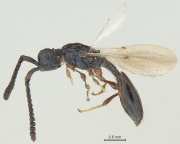 Fig 1. Female, profile |
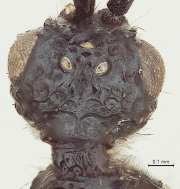 Fig 2. Head, dorsal view |
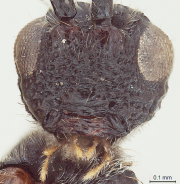 Fig 3. Head, front view |
 Fig 4. Head, profile |
 Fig 5. Antenna (female) |
 Fig 6. Antenna (male) |
|
 Fig 7. Forewing |
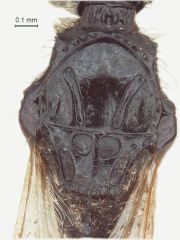 Fig 8. Mesosoma |
 Fig 9. Metasoma (female) |
 Fig 10. Metasoma |
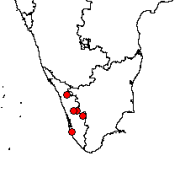 Fig 11. Distribution map |
|
Nomenclature
Odontopria Kieffer, 1905: 9-39. Type species: Odontopria temporalis Kieffer.
Diagnosis
Medium sized robust forms, around 3.5mm long. Head and body usually black, with appendages lighter in colour. Body smooth and shining, lacking micropilosity, but with sparse long semierect hairs, never with foam-like structures. Hairy cushions often indicated on postgena, sides of pronotum and upper part of propleuron.
Head subglobular. Antennal shelf often well developed in lateral view. Head without any armature, but with deep impressed circular foveae or depressions of varied sizes, dorsally a few foveae even larger than ocelli, though much smaller on frons. Median frons less foveate, but with transverse rugosities. Area towards occipital margin with less sculpture. A short carina extending upwards from median occiput. Orbital carina distinct, encircling eyes ventrally. Adorbital carina present dorsally. Mandibles normal, bidentate, not beak-like. Malar sulcus absent. Temples longer than eye height. Antennae in both sexes 13-segmented. Female antennae without a distinct clava, segments gradually enlarged towards tip, apical rim of A1 ventrally excavate and produced into flaps, A13 as long as A12. Male antenna filiform, segment 3 subequal to 4, A4 feebly modified, slightly emarginate. Pilosity on antennae short, not as long as width of A2.
Cervix with foveae and longitudinal striae as on head. Pronotal shoulders angulate. Mesoscutum with distinct and diverging notauli, latter not reaching transscutal articulation. Anterior margin bordered dorsally by small pits on pronotum. Humeral sulcus distinct. Anterior scutellar pits bifoveate. Lateral and posterior scutellar pits sometimes present. Scutellar sheath broad, lower margin bordered by an inner row of fine longitudinal foveae. Sternaulus indicated. Metapleuron densely hairy. Dorsellum with three keels medially. Propodeum with median keel anteriorly raised into a spine, with a dorsal semi-hyaline zone. Nucha indicated in some cases.
Wings fully developed. Forewing venation extending to almost half of forewing length. Costal cell broad. Marginal vein short. Postmarginal vein not distinct and stigmal vein longer than marginal vein, slanting. A nebulous arcuate basal vein indicated at times. Disc of forewing at times medially with a white hairless streak. Marginal cilia of forewings very much reduced, nearly one-eighth of forewing width. Hindwings with submarginal vein complete.
Petiole always longer than wide, usually with longitudinal striae. Anterior margin of T2/large tergite emerging above level of petiole and without a median furrow, utmost with a slight concavity or emargination. Metasoma elongate, basal tergites telescoped under large tergite.
Geographic Distribution
For the distribution of the genus in India, see Fig.11.
Species known from India
1. Odontopria nilamburensis (Sharma)
2. Odontopria spinosa Rajmohana & Narendran
Remarks
A genus restricted to Oriental Region. Members of this genus can be diagnosed by their robust body, presence of impressed circular punctae on head, raised antennal shelf, normal mandibles, 13-segmented female antennae lacking an abrupt clava, distinct notauli, anterior scutellar pit bifoveate, forewings large and wide, with reduced marginal cilia and anterior margin of T2 being concave.
From Spilomicrus, this genus is differentiated at once by its sculpture on head (impressed circular pits and transverse striae on frons).
References
|